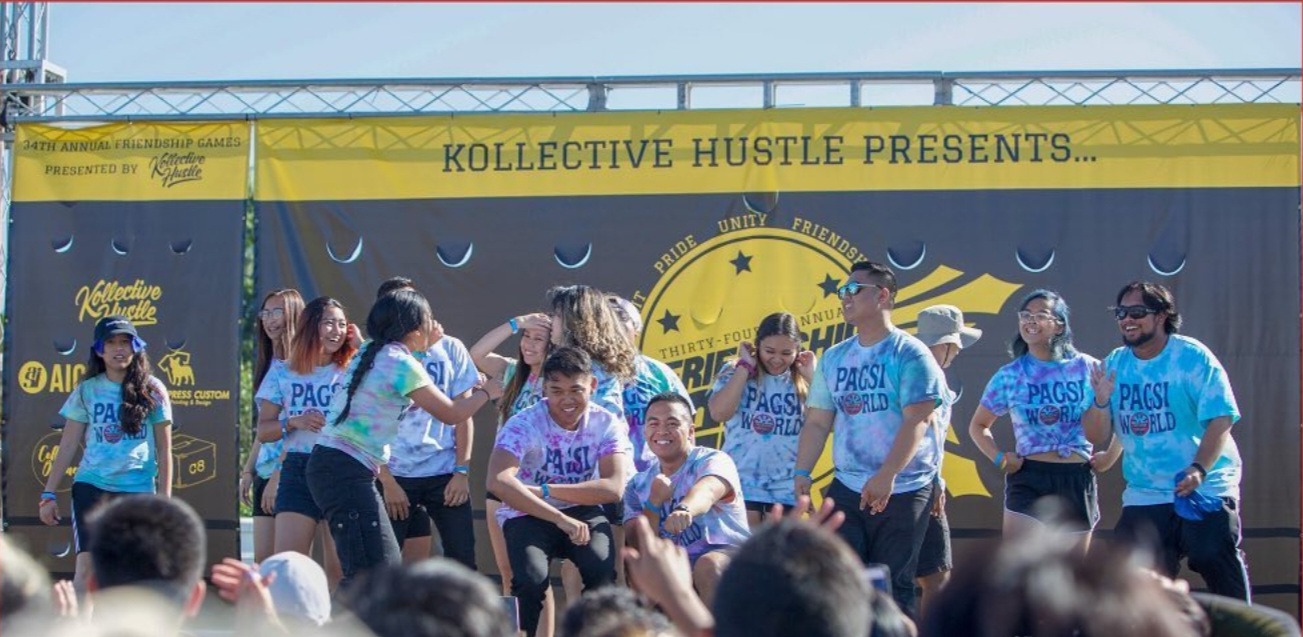Members of Pagsikapan perform in front of a crowd at Friendship Games, which is a large gathering of Filipino-American organizations across the country. Photo courtesy of Pagsikapan.
By Mycah Serdenia, Staff Reporter
As an incoming freshman going into college, it can be very daunting and intimidating. Even more so, when you are entering a school whose majority school population is different from your own ethnicity. As a Filipino-American, I remember entering CSUDH and looking around and not seeing enough Fil-Am students. While CSUDH is among the most ethnically-diverse universities in the United States, for someone of Filipino-American descent, like myself, finding that space was a bit more challenging.
Coming from a high school that was predominantly Latinx, I longed to find a space on campus that allowed me to meet individuals that looked like me and shared the same culture and traditions.
Despite colleges such as CSUDH pushing for diversity and trying to bring groups together, some challenges arise.
Centers like that of the Rose Black Resource Center and Latinx Cultural Resource Center, which opened about a year ago, have housed many African American and Latinx students and have contributed to the diversity and legacy of the university. Even as this remains true, there is still a longing for centers for Asian Pacific Islander students, which the university does not have. Many students, like myself, would greatly benefit from having a center that houses our culture and would allow for a community to grow and be known on campus.
According to our Campus Profile on the university website, Asian or Pacific Islander students make up 10.2 percent of the student body on campus. Comparing this statistic to the number of Hispanic/Latino students, this demographic makes up more than half the student population.
College life wasn’t what I was expecting. I came to school, went to class, and went home. I had yet to make any new friends despite meeting plenty of people in my classes, but it all felt in passing. As the only Filipino kid, it also felt a bit awkward and I often felt out of place.
This was the case until I came across the Involvement Fair, which is an annual event hosted by the Office of Student Life. Here, students have the opportunity to explore different clubs and organizations that exist on campus.
At the event, I found Pagsikapan. Established in 2016, Pagsikapan, or PASC, stands for the Pilipnx-American Student Community.
Surrounded by other clubs tabling for the event, the Pagsikapan table stood, meshed with the crowd, and only one banner advertising the club’s name.
“I knew the club was there,” says Ryan Tolentino, a Clinical Lab Science student and fourth year member of the club. “But it took a while before I finally came across it.”
Filipino-American students on campus had the same struggle discovering CSUDH had a Filipino organization. Many found out either through a friend of a friend, or simply researching on their own.
Collaborating with students and faculty, Pagsikapan’s goal is to unite different cultures and backgrounds, while also sharing Filipino traditions and values.
Here, I finally was able to dive deeper into my culture and take part in activities that I hoped for. Events such as a Pilipino American Culture Night introduced me to traditional dances such as the Tinikling, which involved two people tapping and sliding long bamboo poles while others were stepping in and out of the poles. Tagalog Nights provided an outlet for native speakers and non-native speakers to learn some of the dialects spoken in the Philippines.
Pagsikapan has also worked alongside many of the other organizations here on campus, hosting a workshop on mental and physical health with our Kinesiology Student Association, as well as our Clinical Science Club.
At its heart, Pagsikapan prides itself on making themselves known. Starting off with only a few members, they look to branch off more into the future, collaborating with more clubs and organizations on campus, and ultimately going above and beyond our community of Carson. I’ve had the privilege of meeting a lot of people through this club and it has definitely aided me in my college career through networking and having the opportunity to work on special projects.
As a Filipino-American student, I felt somewhat of an outsider. An organization like Pagsikapan opened a space for Fil-Am students like myself among others to feel proud to be a Fil-Am student here at CSUDH and feel a sense of belonging. With clubs like Pagsikapan representing a small portion of the Asian community on campus, I feel there are many Asian-American students who still need to be heard. One way to accomplish that goal would be the creation of an APIA Resource Center. In doing so, this would create a space for all Asian and Pacific Islander students, incoming or already students here at CSUDH, to build a community and be heard. Having this as a building block I believe will lead to more events being created and ultimately having our presence be known to the CSUDH community.

